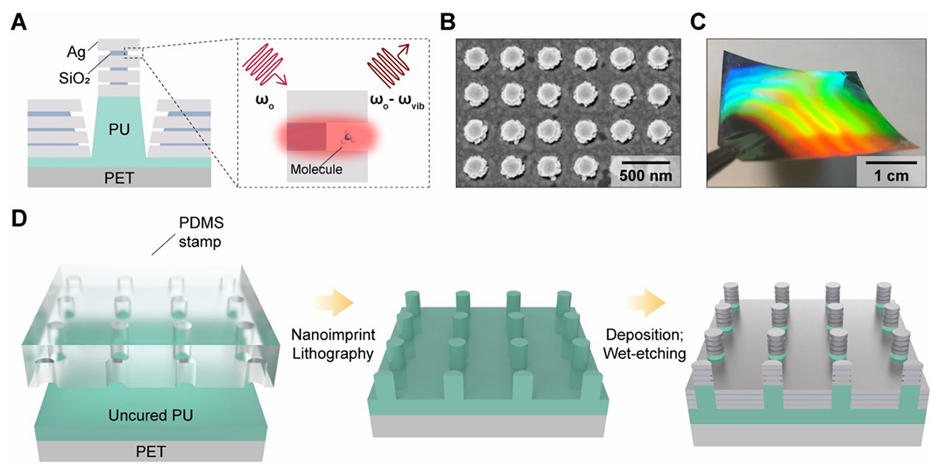커뮤니티
부경투데이
- 국립 부경대학교의 다양한 모습과 소식을 접하시면 부경대학교가 한번 더 가까워집니다.
| 학부생 논문이 국제학술지 표지 실렸다(Undergraduate Student’s Paper Featured on the Cover of an International Journal) | |||
| 작성자 | 대외홍보센터 | 작성일 | 2025-03-21 |
| 조회수 | 958 | ||
| 학부생 논문이 국제학술지 표지 실렸다(Undergraduate Student’s Paper Featured on the Cover of an International Journal) | |||||
 |
대외홍보센터 |  |
2025-03-21 |  |
958 |
국립부경대 학부생 논문, 국제학술지 표지논문 선정 ‘주목’
- 전자공학전공 윤지원·유혜임 … 고성능 3D 표면증강라만분광 센서 개발

△ 연구팀(왼쪽부터 윤지원, 유혜임 학생, 남원일 지도교수) 사진과 저널 표지
국립부경대학교(총장 배상훈)는 전자공학전공 윤지원 학생(학석사연계과정)과 유혜임 학생(4학년)이 공동 제1 저자로 참여한 연구가 SCI급 국제학술지 <ACS Applied Nano Materials> (IF: 5.3) 표지논문(Volume 8, Issue 10)으로 지난 2월 실렸다고 밝혔다.
이들은 표지논문으로 실린 ‘Plasmonic Nanolamination for High-Performance SERS Substrates Based on Vertically Stacked 3D Multiple Nanogaps’(지도교수 남원일)에서 나노적층 공정을 활용해 균일성과 재현성이 우수한 3차원 수직 다중 나노갭 구조를 구현하는 데 성공하며 3D 고성능 표면증강라만분광(SERS) 센서의 새로운 가이드를 제시했다.
SERS는 극미량 물질을 검출할 수 있는 강력한 차세대 분광 분석 기술이지만, 신호의 재현성과 균일성이 낮아 실용화에 어려움이 있었다. 기존의 수평 배향된 나노갭 구조는 10 nm 이하 정밀 제어의 한계와 핫스팟 밀도를 높이는 데 제약이 있었다. 이에 연구팀은 금속-절연체-금속(MIM) 적층 구조를 이용한 나노적층 기법을 도입하는 방식으로 수직 방향의 다중 나노갭을 형성해 고밀도의 균일한 핫스팟을 확보했다.
연구팀은 선택적 습식 식각을 통해 절연층을 제거, 나노갭 핫스팟을 분석 분자에 노출해 SERS 신호 증강 효과를 극대화했다. 실험 결과, 최적의 식각 조건에서 SERS 신호 증강 계수는 최대 1.75 × 108에 도달했으며, 400픽셀 이상의 넓은 영역에서 상대 표준 편차(RSD) 11%로 높은 균일성을 입증했다. 또한, 나노임프린트 리소그래피 공정을 이용해 16 cm²의 대면적 기판을 저비용으로 재현이 가능하도록 제작하는 데 성공했다.
국립부경대 남원일 교수(전자공학전공)는 “이번 연구는 기존 SERS 기판의 균일성과 재현성 한계를 극복한 새로운 접근법을 제시했다는 점에서 큰 의미가 있다. 이번에 제작한 나노적층 SERS 기판은 환경 분석, 바이오센서, 식품 안전 및 폭발물 탐지 등 다양한 실용 분야에서 활용될 수 있을 것으로 기대된다.”라고 밝혔다.
한편, 윤지원 학생과 유혜임 학생은 국립부경대 전자공학전공 남원일 교수의 나노플라즈모닉스 연구실에서 학부연구생으로 연구하는 가운데 이번 성과를 거뒀다. 윤지원 학생은 SERS를 통한 환경 센싱 관련 연구를, 유혜임 학생은 디지털 SERS 연구와 SERS를 활용한 암세포 다변량 분류 연구를 수행 중이다. <부경투데이>

△ (위)나노적층 SERS 기판의 모식도와 실제 사진 (아래)나노적층 SERS 기판의 제작과정 이미지.
Pukyong National University Undergraduate Paper Selected as Cover Article in International Journal
- Electronic Engineering Majors Yoon Ji-won and Yoo Hye-im Develop High-Performance 3D Surface-Enhanced Raman Spectroscopy Sensor
Pukyong National University (President: Bae Sang-hoon) announced that a research paper by Electronics Engineering students Yoon Ji-won (combined master's and doctoral program) and Yoo Hye-im (4th-year student) was published as the cover article in the SCI-level international journal <ACS Applied Nano Materials> (IF: 5.3), Volume 8, Issue 10, in February.
In the cover article titled ‘Plasmonic Nanolamination for High-Performance SERS Substrates Based on Vertically Stacked 3D Multiple Nanogaps’ (supervised by Professor Nam Won-il), the researchers successfully developed a 3D vertical multi-nanogap structure with excellent uniformity and reproducibility using a nanolamination process, providing a new guide for high-performance surface-enhanced Raman spectroscopy(SERS) sensors.
SERS (Surface-Enhanced Raman Spectroscopy) is a powerful next-generation spectroscopic analysis technique capable of detecting trace amounts of substances, but its practical application has been challenging due to low signal reproducibility and uniformity. The conventional horizontally oriented nanogap structures faced limitations in precision control below 10 nm and difficulties in increasing the density of hotspots. To overcome these issues, the research team introduced a nanolamination technique using a metal-insulator-metal (MIM) stacking structure to create multiple vertical nanogaps, ensuring high-density and uniform hotspots.
The research team maximized the SERS signal enhancement effect by selectively wet etching and removing the insulating layer, exposing the nanogap hotspots to the analyte molecules. Experimental results showed that under optimal etching conditions, the SERS signal enhancement factor reached up to 1.75 × 10^8, demonstrating high uniformity with a relative standard deviation (RSD) of 11% over an area of more than 400 pixels. Additionally, the team successfully created large-area substrates (16 cm²) at a low cost, making them reproducible using nanoimprint lithography.
Professor Nam Won-il (Department of Electronic Engineering, Pukyong National University) stated, "This research presents a new approach that overcomes the limitations of uniformity and reproducibility of conventional SERS substrates. The nanolaminated SERS substrate we developed is expected to be applied in various practical fields such as environmental analysis, biosensors, food safety, and explosives detection."
Meanwhile, Yun Ji-won and Yoo Hye-im achieved this result while conducting research as undergraduate researchers in the Nano-Photonics Lab of Professor Nam Won-il at Pukyong National University's Department of Electronic Engineering. Yun Ji-won is working on environmental sensing research using SERS, while Yoo Hye-im is conducting research on digital SERS and multivariate classification of cancer cells using SERS. <Pukyong Today>